The iPhone 4 Redux: Analyzing Apple's iOS 4.0.1 Signal Fix & Antenna Issue
by Brian Klug & Anand Lal Shimpi on July 15, 2010 12:28 PM EST- Posted in
- Smartphones
- Apple
- iOS 4
- iPhone 4
- Mobile
Better at the Low End, Mixed Feelings Everywhere Else
Brian came up with the plan to enable the numerical signal strength visualization and executed on it very well in our original iPhone 4 review. Since then there’s been a disturbing amount of debate as to whether or not this actually amounts to a problem with the phone.
Part of the confusion stems from the fact that doing this sort of antenna testing in a real world scenario is time intensive. As Brian mentioned on the previous page, for today’s article both of us were driving around our respective cities, stopping at various locations, measuring signal strength and comparing it to bar mappings in order to produce the charts you saw on the other page.
There’s no denying that Apple has played a significant role in why there continues to be debate about the iPhone 4 antenna. By simply addressing the pre-4.0.1 bars not being a good representation of signal strength and ignoring the fact that the iPhone 4 does lose more signal strength than competing phones depending on how you hold it, Apple manages to convince its faithful that there’s nothing wrong while driving its critics to demand a recall.
My mother always taught me that honesty is the best policy and presumably I’m not the only one in the world who was privy to this information. Had Apple come clean with both of these facts (the bar mapping and the signal attenuation issue) early on we’d be in a far more clear cut world today.
We have consistently argued that the 4’s antenna is a design choice by Apple. As we’ve seen in our testing there are situations where the iPhone 4’s antenna makes things better (e.g. holding onto calls with very low signal strength) and other situations where the design makes them worse (e.g. holding it wrong in situations with low signal strength). I wanted to describe the inconsistency in greater detail so I went out with an iPhone 3GS and 4 and documented my experiences.
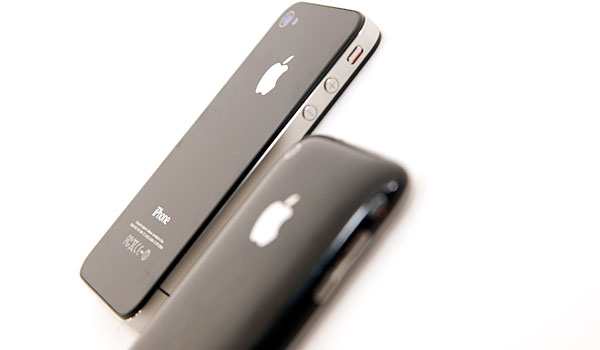
In practice I found three things that were true about the iPhone 4’s antenna behavior compared to the 3GS.
Reception in average conditions is sometimes significantly better on the iPhone 4 than on the 3GS. Take a look at the image capture below. In the same exact location we have better reception on the 4 than the 3GS. Granted this could be due to a number of variables outside of the phone’s antenna itself, but it happened enough times that it’s worth reporting. This is the positive to Apple’s external antenna design - you can and do get better reception. Unfortunately the tradeoff is the scenario I just described before this.
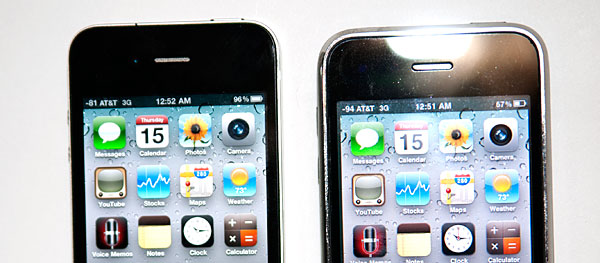
iPhone 4 (left) at -81 dBm vs. iPhone 3GS (right) at -94 dBm
Signal strength is sometimes the same as or worse than the iPhone 3GS. This is really where the problem comes into play. In the shot below I have the 4 and 3GS sitting next to one another and they are displaying roughly the same signal strength. We’ve already proven that holding the iPhone 4 attenuates its signal more than the 3GS, which results in the frustration we’ve seen expressed by many at this point. In situations where the 4 has the same signal as the 3GS, holding the phone is going to drop it to levels significantly worse than the 3GS. If you’re in an area with low signal strength to begin with, holding the phone is going to bring you down to dangerously low levels.
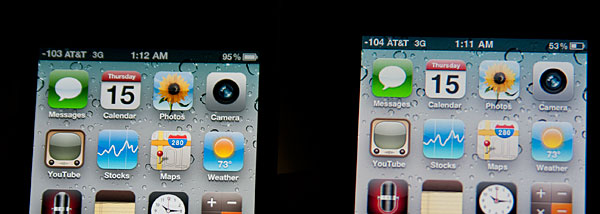
iPhone 4 (left) at -103 dBm vs. iPhone 3GS (right) at -104 dBm
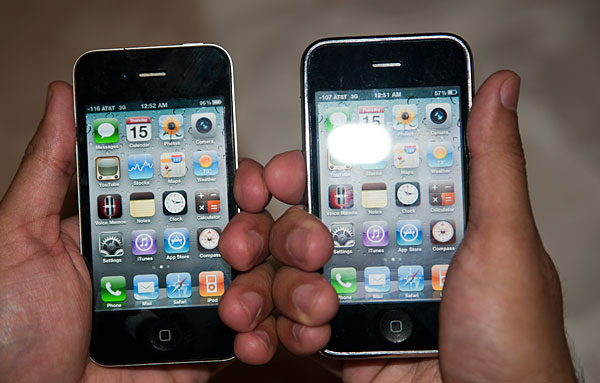
iPhone 4 being held tightly (left) at -115 dBm vs. iPhone 3GS being held tightly (right) at -107 dBm
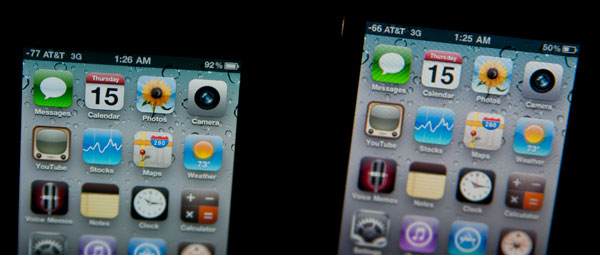
iPhone 4 (left) at -77 dBm vs. iPhone 3GS (right) at -66 dBm
The iPhone 4 is better at holding onto calls and data at very low signal levels. We’ve mentioned this one before but it’s worth reiterating. The new antenna does let me make calls and transmit data at very low signal strength. With the iOS 4.0.1 update I was able to make a call at -115dB on the 3GS, however the call did drop within a minute of starting it. By comparison I was able to have a much longer conversation without dropping the call at -120dB on the 4. By no means is this a scientific comparison, but anecdotally both Brian and I feel that the low signal strength performance of the iPhone 4 is better than the 3GS.

A call at -120 dBm on the iPhone 4
If you’re keeping tabs you’ll note that this is what is traditionally referred to as a trade off. Apple opted for good performance in low signal situations (and style of course) over maintaining consistently better or unchanged radio performance compared to the 3GS. I would personally consider this to be an unnecessarily risky design choice, particularly for a smartphone vendor. Note that it's nearly impossible to separate out the antenna from the rest of the iPhone 4 platform to determine exactly what is responsible for the phone's signal sensitivity in various situations. All we ultimately know is how physically interacting with the antenna impacts reported signal strength.
I can’t stress enough that this issue impacts all users. The variability is in how strong of a signal you have to begin with. That’s the absolute only reason there’s debate in these discussions from phone to phone. At my desk I don’t get great reception on AT&T. With the iPhone 4 I’m usually at -96dBm. If I keep a tight grip on the phone or if I’m holding it to send text messages I can sometimes lose all signal entirely. This is a combination of poor reception at my house and the fact that the 4 loses more of its signal than other phones when held certain ways.
Brian on the other hand has much better reception at his home. To him, the signal strength drops but it does not drop enough for this to be a problem. I consider myself to be on the border. If I’m mindful of how I’m holding the phone it’s not an issue, and even most of the time if I’m not paying attention to it it’s not an issue. However there are definitely times when it does become a problem. I wouldn’t consider it to be the majority of the time or even more than 10% of the time, but it happens enough for me to have to think about it. Ultimately this is why I consider Apple’s design here to be unnecessarily risky. Introducing a change with stylistic and technical benefits where the downside is limited but potentially very noticeable is just ballsy.
Luckily for Apple, there are things that can be done about it.










146 Comments
View All Comments
MichaelEmpire - Sunday, July 18, 2010 - link
If anybody can suggest the way or utility to have indicator in DB ? Other than resore from the previuose jailbroken phone.Thank you.
386DX - Sunday, July 18, 2010 - link
Great job once again. While your look at the iPhone4 and its antenna issue is fairly complete there is one more thing I and I'm sure others would be interest in. We know that the bumper appears to fix the antenna issue with the iphone 4 but it would be interested in seeing if using a bumper has any effect on the battery life. Looking at the original iPhone4 review comparing battery life I can't help notice that the 4 has a 16% higher cappacity battery but only gave 12% running time when using wifi over the 3GS. Yet when it came to 3G and talk time it gave 38-58% more running time. This leads me to believe the gain in battery life is mainly due to the external antenna design (allowing the phone to use less W to maintain signal). I wonder if using a bumper would affect battery life possibily because the phone may need to run the transmitter at a higer power to maintain the same signal.tzikis - Sunday, July 18, 2010 - link
Hi Brian, sorry to bring this up again, but the link you provided does not mention the width of the tape. Could you please measure it and let us know what is the proper width for a tape that will perfectly fit the iPhone?dsj123 - Monday, July 19, 2010 - link
Thanks very much for all the effort to do the iPhone4 review(s); very much appreciated!The0ne - Monday, July 19, 2010 - link
I'm seriously laughing my ass off just reading the comments for the review. It is clear we have tons of consumers that can and will "live" with just about any crap that they can't find themselves to peel away from. I'm always amazed at this phenomenon. It's got to be the greatest mystery ever.And it is astoundingly clear most members have little to absolutely NO CLUE how RF testing is carried out, nor apparently does Anandtech. This is why writing something that is not consistent and bias persuades the masses of readers to believe what they don't even know in the first place. All they know and want to believe is that Anandtech, or in this case, Anand and Brian said it's AT&Ts fault, REGARDLESS that others AT&T phones do not have the issue nor require any special tape/cases.
Look how many loyal members you have supporting you when they really don't have much experience or expertise in the engineering, including RF, field. As one of the original poster stated, this is so bias it's not even funny. An article detailing how to scotch tape the iphone to normal working conditions while at the same time claiming it's the providers fault? You have got to be kidding me. Unbelievable but not surprising I guess.
v12v12 - Tuesday, July 20, 2010 - link
1) I'm lmao bc of all the boasting and bellowing about numbers and credibility of "engineering" regarding this article that YOU, yes YOU haven't even shown you can grasp nor expand our knowledge base on the subject lol.2) STFU and prove you know more than what the article's OP(s) have stated, or GTFO?
3) Again you have ZERO proof of your claim, even when you try and disparage other's; you are the clown here until so forth.
4) Everything you've stated thus far is 100% conjecture, speculation and BASELESS w/o PROOF.
5) WAITING FOR PROOF of your claims, kid... Lets SEE just how much you actually know... Or as said—STFU + GTFO.
So... just WHO really doesn't have an understanding of the RF/Engineering field; apparently you haven't shown any either... laughing my ass off.
Kthxbye.
Janet55 - Monday, July 19, 2010 - link
hmm, I read the news "Live from Apple's iPhone 4 press conference".Dude. I'm 99% sure there will be no recalls or h/w fixes. Like some dude called it, they'll say
1) 99% phones are okay
2) 1% suffer from that issue, which still makes us the best and greatest
3) we're giving you free/discounted bumpers so worship us forever
While I love their products, of course I do hope Apple steps up on the iPhone 4 improving as soon.
The iPhone 4 tempting features, HD Video Recording and lovely pictures you're surprised in iFunia iPhone column
tlindaas - Tuesday, July 20, 2010 - link
It seems the iPhone 4 gets better overall reception compared to other phones because of the large, exposed, external antennas, but at the same time this alternative design means is is more sensitive to the disturbances from human hands.What I would like to know is this: When holding the iPhone 4 as badly as possible, is it better or worse reception-wise compared to holding a "normal" phone as badly as possible, under poor conditions?
If a normal phone start to drop calls in the 107-113 dBm range, and the iPhone 4 hold the calls all the way down to -121 dBm, shouldn't this imply that deathgripped iPhone 4s gets roughly the same reception as deathgripped normal phones? Point in case: HTC Nexus One, which drops 10 dBm held naturally, compared to 20 dBm for the iPhone 4:
http://www.anandtech.com/show/3794/the-iphone-4-re...
viewfly - Tuesday, July 20, 2010 - link
Brian & Anand:Great fair review guys. I too can display RSSI in dBm in my iPhone 4: it was passed down from my 3G ->3GS and now IP4 with iTunes. I also examined data speeds with speedtest.net.
My results. Have you seen the same?
1. I'm right handed and don't normally do a tight grip. I have a bumper, but I can place my fingers anywhere on the metal SS band (except lower left 'sweet' spot) and see no change in data speeds or RSSI.
2. I can take my thumb and index finger and bridge the gap above and below, with no adverse effects...only when I place my finger directly on the gap is there a problem ( 20+ dB loss). Also, placing a finger directly on the top gap (by earplug) produces no effect. The top gap also separates the two antenna, just like the lower gap. Interesting that it has no effect.
3. When in a lower RF signal range ( -110 to -95 dBm) I can see data stop and loss of 22 dB when placing my finger directly on the lower gap...my fingers elsewhere, or even a few mm's near the gap have no great effect.
4. When in a hight RF signal range ( -41 to -78 dBM) I see NO data or RSSI dB adverse effect at all. I had expected to see it drop by 22 dB too...but that would be ok...but instead I mostly see no change. Only once out of 10 tries did I see a dB change. I think I understand why some see to antenna issue at all.
5. I tried kapton tape too. Just over the gap. It helped (data speeds where 850 kbps instead of 2200 kbps) and dB dropped less...but it was not perfect. I'm guessing that a coating would not help either. Only the bumper helped completely. I'm afraid many people will be ripped off buying tape from vendors...
In general, being right handed and the phone made for right handers ( volume on left side of phone), and the way that I hold the iP4...I have really no problem going without a case. I was surprised how easy it is to avoid. Even in horizontal browsing mode...my fingers can touch the metal but avoid the lower gap.
Maybe Apple should give people the RSSI display option...it would help give good feedback to the user...we humans are easily trained!
viewfly - Tuesday, July 20, 2010 - link
P.S.On item 4, I meant to say that i see no effect with my finger even directly on the lower left gap when in a high RF signal area ( -41 to -78 dB). I haven't mapped out carefully the range of -78 to -95...it takes time!
Given that the 1mm gap is only about 0.01% of the total SS metal surface area...I am finding it pretty easy to avoid. So I'm having no problem operating without a case.